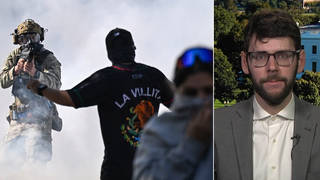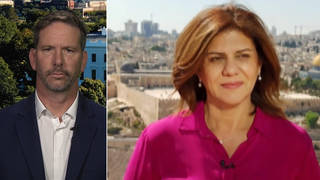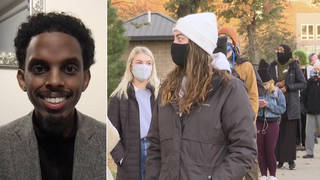
Guests
- Phyllis Bennisfellow of the Institute for Policy Studies and author, most recently, of Ending the US War in Afghanistan: A Primer.
In Afghanistan, the number of civilian casualties continues to rise. On Tuesday, at least eight people died after a bomb exploded in the southern provincial capital of Lashkar Gah amid a major US-led offensive in the area. Local authorities said all those killed in the attack were civilians. Meanwhile, Afghanistan’s government has condemned a NATO air strike on a convoy on Sunday that killed twenty-seven civilians, including four women and a child. NATO commander General Stanley McChrystal went on Afghan television to apologize for the attack. Last year was the deadliest of the war for civilians and foreign troops. And while there is no reliable count of the number of Afghans killed, the number of US soldiers killed in the war has reached 1,000. [includes rush transcript]
Transcript
AMY GOODMAN: In Afghanistan, the number of civilian
casualties continues to rise. On Tuesday, at least eight people died after a bomb exploded in the southern provincial capital of Lashkar Gah amidst a major US-led offensive in the area. Local authorities said all those killed in the attack were civilians.
Meanwhile, Afghanistan’s government has condemned a NATO air strike on a convoy on Sunday that killed twenty-seven civilians, including four women and a child. NATO commander General Stanley McChrystal went on Afghan television to apologize for the attack, and Defense Secretary Robert Gates pledged a thorough investigation but blamed the Taliban for using, quote, “civilians for cover.”
ROBERT GATES: The thing to remember is that we’re at war. We are doing everything possible. General McChrystal is doing everything humanly possible to avoid civilian casualties. But it is also a fact that the Taliban mingle with civilians, they use them for cover, which obviously complicates any decision process by a commander on the ground in knowing whether he’s dealing with the Taliban or innocent civilians, or a combination of the two. I’m not defending it at all. I’m just saying that these kinds of things, in many respects, are inherent in a war. It’s what makes war so ugly.
AMY GOODMAN: Last year was the deadliest of the war for civilians and foreign troops. And while there is no reliable count of the number of Afghans killed, the number of US soldiers killed in the war has reached a thousand, this according to the independent website icasualties.org.
Meanwhile, the Afghanistan war has also surpassed the American Revolutionary War in duration to become the second-longest war in American history, at eight years, four months and sixteen days.
President Obama has twice escalated the war since taking office, first by pledging 17,000 troops a year ago, then an additional 30,000 troops in December.
Well, our next guest argues the war in Afghanistan, quote, “simply isn’t going to work. It won’t bring security to Afghans. It won’t turn Afghanistan into a democracy. And it won’t make us safer.” That’s Phyllis Bennis. She’s a fellow of the Institute for Policy Studies and author, most recently, of Ending the US War in Afghanistan: A Primer. She joins us from Washington, DC.
Phyllis, welcome to Democracy Now! The latest news, the bombing of this minibus convoy that killed twenty-seven people, civilians, that now General McChrystal has made a videotaped apology for, talk about this.
PHYLLIS BENNIS: Well, in a certain way, what Secretary of Defense Gates said this morning is true: this is what happens in war; this is why war is “so ugly,” he said. He could have said and should have said, this is especially why an occupation war in another country, where you don’t know the players, you don’t know the culture, you don’t have good intelligence, and you’re participating in a civil war in someone else’s land, is inevitably going to reach these kinds of terrible results.
There are already reports, as you mentioned, Amy, eight more people at least, civilians, killed today. The number of Afghan civilians is at least fifty just this week, just in the period of this new offensive in Marjah in southern Afghanistan. And I think that what we’re seeing is a very serious demonstration, for any who doubted it, that this is a war against a vast population of Afghanistan. The claims that we’re — our new strategy is different, that our new strategy is not to kill civilians — the only way to stop killing civilians is to stop the killing. That means to stop all offensive actions, to stop and withdraw the troops, pull back the drones. This is the only way that there’s going to be an end to civilian casualties.
The notion that it’s the Taliban’s fault because they are among civilians, well, the problem is the Taliban come from those communities, they are those civilians. Many of the Taliban fighters who have, in the words of many US and strategy officials, talk about how the Taliban faded away with this new offensive in Marjah. They faded away because they live there. They’ve gone back to their families, back to their farms. And they will rise to fight again, presumably, if their interests are at stake, whether those interests are economic, whether they are issues of loyalty and connection to their communities.
This is the inevitable result of this kind of a war, the escalation that we have seen during President Obama’s first year. And yes, there is no question, this is President Obama’s war. He claimed it as his own, even during the campaign. The fact that we have now reached a thousand US casualties, and we don’t know — as you mentioned, we don’t know significantly accurate totals of the vast number of Afghan civilians who have died in this war. We know that it has been escalating. There are now — by the time that President Obama’s most recent escalation is finished, which is supposed to be in the next several months, there will be over 100,000 US and allied troops occupying Afghanistan. And there are already over 104,000 US paid mercenaries in Afghanistan in this war.
So the war has escalated enormously in this period, and there’s going to be a great deal of work to do to bring that war to an end. That’s very much why David Wildman and I wrote this book on how to end the US war.
AMY GOODMAN: So, how, Phyllis? How do you end the war? What’s the exit strategy?
PHYLLIS BENNIS: The exit strategy has to start by ending the killing. There has to be a unilateral ceasefire that can set the stage hopefully for a reciprocal ceasefire from all the various parties that are at war here. It has to include — this isn’t a situation where we can simply say, “Oh, let’s pull out the troops, and then we’re done.” Pulling out the troops, ending the drone attacks, ending these attacks that so consistently are killing civilians, is only step one. It’s only step one. We need to reengage with Afghanistan in an entirely different way than has been made possible. We need to look at serious development assistance.
We hear that the Marjah offensive that is now underway, that the US says is so important — it’s become important because there are so many thousands of US troops engaged in it now — that it’s important as a showpiece. It’s important — and they admit this — it’s important for the political goals, not the military goals, the political goals of bringing into Marjah what the US officials are now calling a government in a box, a government standing on the sidelines ready to come in and govern, and new aid workers ready to come in to provide all the services that have been missing.
Well, the problem is that all those aid workers are Americans, and the so-called government in a box is a government created under US control in Kabul made up largely, unfortunately, of different tribal and ethnic and linguistic groups than the people who actually live in that area. It’s likely to be seen as a foreign government, not quite like the US directly, but not part of the local community, which has always been the basis of how Afghanistan operates.
And until the United States is ready to operate on that kind a local level in conjunction with local leaders, women and men, Islamist and more secular people, which it certainly has not been prepared to do, the real need is for negotiations. The US cannot be in charge of those negotiations, but it has to stop preventing those negotiations. The Taliban will have to be involved in those negotiations, because they represent a component of the population and a component of the power. And if you’re serious about ending warfare, negotiations have to bring everybody to the table. We’re not going to be able to stand back and say, “Well, I don’t like what they stand for.”
It’s true, I don’t like what the Taliban stands for. They have been terrible in their ruling periods to the people of Afghanistan, particularly, but not only, to the women. But if we look at who the US is backing, these warlords that are suddenly our guys, they’re no better. If we look at the history of who began the terrible — what has now become commonplace in some terrible parts of Afghanistan, where women face the danger of having acid thrown in their faces if they dare to go to school, that didn’t begin with the Taliban. That began with a great supporter of the United States, one of President Reagan’s favorites, a warlord of the time, Gulbuddin Hekmatyar, when he was a seventeen-year-old student and decided on his own, back in the late 1970s at the University of Kabul, he didn’t like women going to school. He invented that tactic.
So we have to look at what is really going to make the situation better. For me, looking at the situation of Afghan women, which is such a terrible situation for that population, what we’re looking at is that after eight, almost nine, years of US military occupation, the women of Afghanistan face the highest level of maternal mortality, meaning that more Afghan women die in childbirth than anywhere else in the world. And just a month or so ago, Amy, UNICEF, the UN’s children’s fund, announced that, in their new assessment, Afghanistan was now the worst place in the world for a child to be born. It beat out Sierra Leone. The worst place for a child to be born, after almost nine years of US occupation and a thousand US troops dead, and how many thousand are terribly injured?
The money that we are paying, aside from the human cost, the 30,000 escalation that’s now underway is costing about a million dollars per soldier. That same million dollars could cover twenty workers in this country for good green jobs, a $50,000 a year job with benefits and a living wage. What’s going to make us safer? A war that’s antagonizing people consistently, that’s creating new terrorists for every time we happen to get the right guy, which seems to be about never these days because we’re getting civilians instead? Or, real jobs to build up our economy and provide real aid for the people of Afghanistan? That’s the set of considerations we have to look at. There’s no silver bullet here. There’s no silver peace tactic. There’s a whole set of things —-
AMY GOODMAN: Phyllis Bennis -—
PHYLLIS BENNIS: — that we’re going to have to do.
AMY GOODMAN: BBC just reported that Western diplomats have expressed concern about a decree from Afghan President Hamid Karzai granting him total control over a key election body. The move gives him the power to appoint all five members of Afghanistan’s Electoral Complaints Commission. This is the watchdog group that helped expose massive fraud in last year’s presidential election and forced Karzai into a second vote. Your response?
PHYLLIS BENNIS: Well, I think we’re going to see another massive level of corruption. This is a situation in which, under the best of conditions, holding an election under conditions of military occupation means the election cannot be free and fair. Could it be more or less representative of what people believe? Maybe it’s possible. But when one party in a completely divided nation, a nation which does not have a history of focusing its legitimacy on a strong central government, but rather has historically provided legitimacy to local officials, local movements, local shuras or councils, collaborations of villages and tribal leaders, women’s organizations, all of the various social forces, they have had the power and the legitimacy, not what happens in Kabul. The president, Karzai, is known as the mayor of Kabul for the simple reason that he doesn’t have much influence outside of the capital.
AMY GOODMAN: Phyllis Bennis —-
PHYLLIS BENNIS: The fact that he’s now claiming even additional power, it means it’s not going to work.
AMY GOODMAN: Final question, the antiwar movement -— what do you think — and you end your primer, Ending the US War in Afghanistan, with this — what do you think the antiwar movement needs to do?
PHYLLIS BENNIS: We need to have a very powerful and very different kind of antiwar movement. We need an antiwar movement that links our work with the powerful new movements that are just beginning to rise in response to the economic crisis in this country and around the world. We need to link our work to the people that are working on the demand for jobs, on people that are demanding climate justice, on people that are demanding healthcare, in this country as well as around the world.
The wars in Afghanistan and even Iraq, where it continues, are no longer the public centerpiece of White House strategy the way they were during the Bush years. We are part of something much larger now. We need an antiwar movement that is in fact a component of something much larger, rather than being primarily something that is itself leading that fight back. We’re going to have to mobilize in different ways with different allies. The costs of war are going to be key. And I think that’s going to be one of the most important shifts that we see in this new antiwar movement, that we work as much with people that are fighting for new green jobs as we do fighting against the travesty of civilian deaths in Afghanistan or Iraq.
AMY GOODMAN: Phyllis Bennis, I want to thank you very much for being with us. Congratulations on your new book with David Wildman called Ending the US War in Afghanistan: A Primer.
PHYLLIS BENNIS: Thanks, Amy.












Media Options